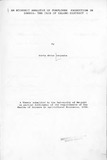| dc.description.abstract | The government of Zambia has intervened in sunflower
production to stimulate its production and achieve selfsufficiency.
A number of interventions including the pricing and
marketing policies have been used to stimulate production.
However, self sufficiency has not been attained. About 62% of the
country's vegetable oil requirements are still met by imports.
Existing literature highlights that there is a link between
policies and low agricultural production in the developing
countries. The interventions create disincentives for production.
This study was undertaken to determine the incentive effects of
policies on sunflower production. The other objectives were to
determine the efficiency of sunflower production in Zambia and
estimate the likely effects of further devaluation and of price
liberalisation on sunflower production.
Using the Policy ,Analysis Matrix (PAM) methodology the study
found that the interventions had not been conducive to attainment
of self-sufficiency. Only a few agricultural marketing
institutions had emerged, prices had been depressed while the
provision of inputs and payment of farmers for their produce had
left much to be desired. The policies had ultimately caused
distortions and induced market failures creating disincentives for
farmers. The study found that the sunflower producer price was
depressed by 87% relative to its world market equivalent. This
translated into the depression of production by 59% given the
sunflower producer price elasticity of 0.68.
(iv)
As compared to maize it was found that the disincentives for
sunflower were greater. Not only revenue was depressed for
sunflower (97% for sunflower and 92% for maize) but input provision
was also worse for it. Sunflower was at an added disadvantage
because maize is a staple food besides being a cash crop. Thus
even if it was unprofitable maize would still be grown for food
needs.
The social profitabilities for the 2 categories of sunflower
production were greater than zero. They were found to be
ZK20,530/HA for small-scale and ZK37,600/HA for medium-scale. This
indicated that producing sunflower in Zambia was an efficient
undertaking. It was therefore recommended that sunflower
production should be encouraged in Zambia .
In relation to devaluation of the Kwacha and liberalisation of
input and output prices, the study found that these measures were
likely to induce increased sunflower production. These measures
would move sunflower production from being unprofitable to
profitable in private prices. It was further noted that if these
changes were accompanied by better marketing services such as
improved input (particularly improved seed and fertiliser)
provision, sunflower production was likely to rise even more.
The study concluded that sunflower production was an efficient
enterprise. However, the interventions had created disincentives
for sunflower production and consequently depressed its production | en |

